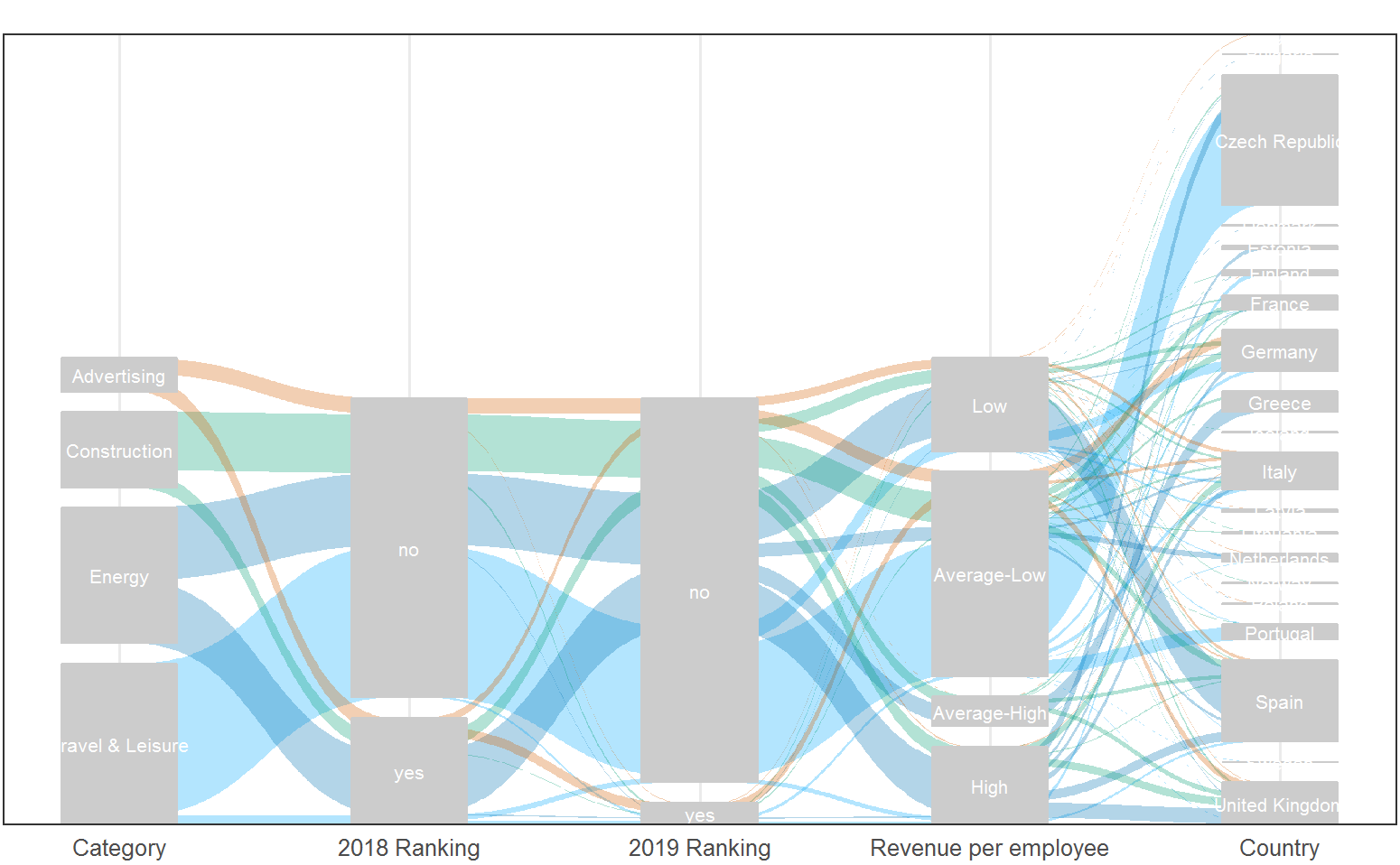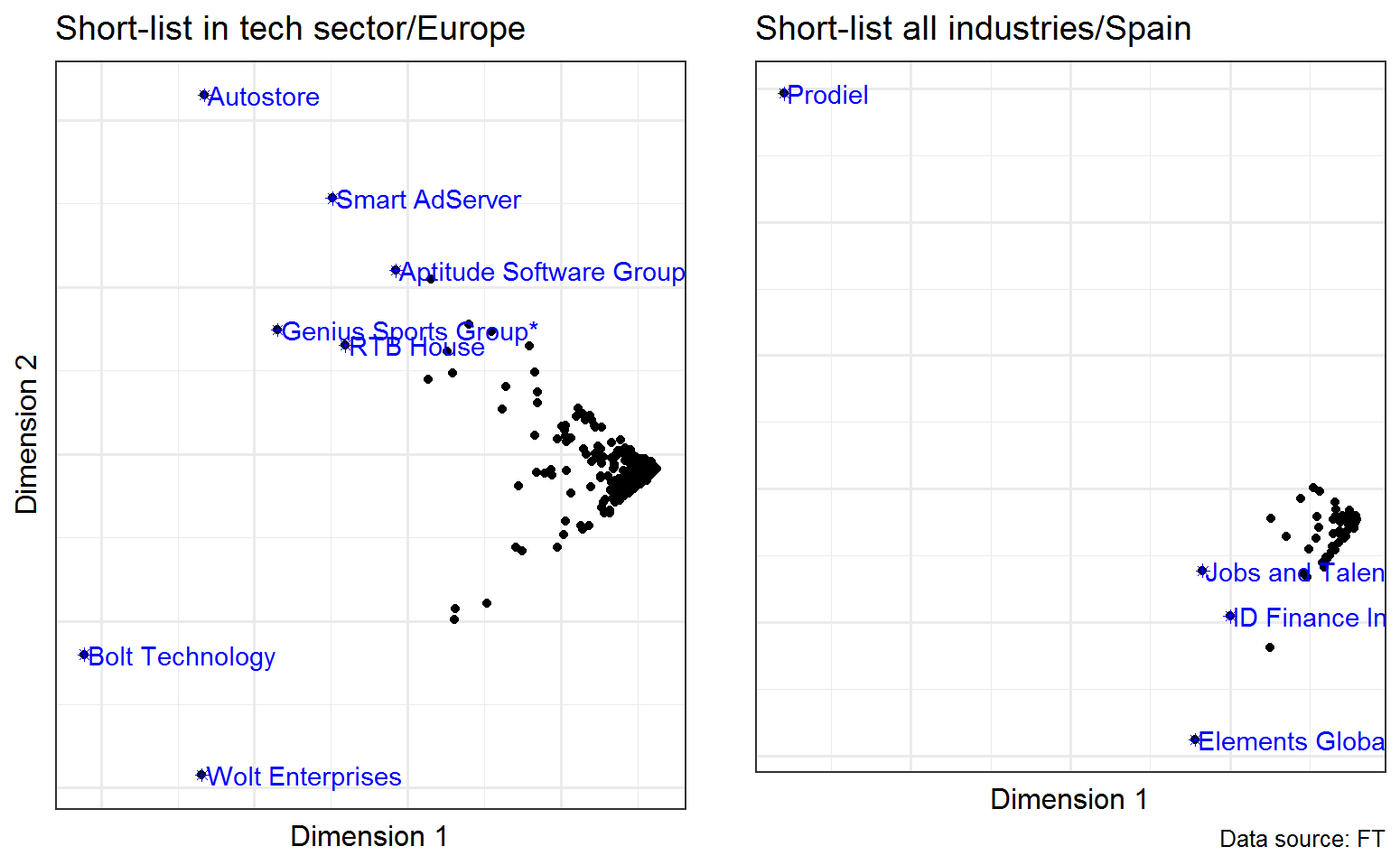Visualisation-led approach providing way-forward
Challenge
Having very much data can be overwhelming and after several time-consuming analysis it might happen that you won’t find meaningful conclusions or insights. This is a nice example where a large data set can rise many questions, just being so large that none specific insight can be derived or extracted, leading to paralysis by analysis. That was the situation of a PE fund that needed quickly understand and capture actionable trends from current high-performing companies in Europe to better re-balance its portfolio of companies.
With that in mind, and having a very good data-set with 1,000 companies across Europe the starting point was really promising, as you can see below:
| Rank | Name | Country | Category | Grotwh Rate (3y) | CAGR | 2018 Rev(m) | 2015 Rev(m) | EEs | Funding Year |
|---|---|---|---|---|---|---|---|---|---|
| 917 | PROPULSE IT | France | Support Services | 1.83 | 0.414 | 3.40 | 1.20 | n/a | 2014 |
| 918 | GAC TECHNOLOGY | France | Technology | 1.82 | 0.413 | 4.05 | 1.44 | 53 | 2007 |
| 936 | Be-Cloud | France | Support Services | 1.77 | 0.405 | 5.55 | 2.00 | n/a | 2012 |
| 19 | getAir | Germany | Industrial Goods | 47.05 | 2.636 | 5.30 | 0.11 | n/a | 2014 |
| 7 | Enens | France | Energy | 86.03 | 3.432 | 100.98 | 1.16 | 2 | 2015 |
| 380 | Bunker Partner | Estonia | Energy | 4.47 | 0.762 | 35.72 | 6.53 | 2 | 2015 |
At the end of the page, you have additional data should you want to navigate through them1.
Solution
Rather than answering the usual questions like where do organizations perform better, which types of business categories,…the ability to visually explore and find patterns in data is key when analyzing large data-sets with so many variables.
That’s why it’s interesting to have the ability to select from the whole myriad of graphical options how to present the data, so it allows exploration amongs the business stakeholders.
With a first graph, we can easily grasp which countries have an important number of companies in the different categories (based upon $). We can understand as well in which country we have “vertical champions”, with revenues much higher that the other players.Now it’s easy to spot where some interesting companies might be present: verticals and volume of business.

Figure showing the presence of champions per category and per country, ordered from least to most represented categories.
Sharing the chart and discussing openly is a good way to help people brainstorm: looking into verticals that are present in a few countries (i.e. legal category seems to be something related to each geography, batteries and defense not being a big bet)) vs categories present in more than 10 countries (technology,energy,construction) that are pervasive across the board, because that’s where there seems to be a higher market and therefore opportunities to scale businesses.
With that idea, we focused on verticals that are present in several geographies and got the following one,ending up with 12 categories that are present in more than 9 geographies.
Now we can see how much competition there are across the different categories and also the number of champions we have in each category:

Figure showing the distribution of companies revenues across business categories.
Let’s take now a deep look into the Energy,Travel, Construction and Advertising category (categories with no clear champions yet and medium-sized revenues):

Figure showing how companies mark on different performance criteria
From this graph, we can visually aplly some filters to a selected number of companies to realize that just a few companies have a track-record of performance (on the ranking for the last two years), and even less companies have a high or average-high revenue per employee.
So, from a list of 1,000 companies, we ended up through a couple of niche charts with a handful set of short-listed companies to dig deeper. Interesting to note as well how Spain and UK seem to be doing well in the energy category with several companies, and Czech having a good share of the Travel and Leisure companies. Teh graphi below is a dynamic one so you can zoom into to check teh details.
Figure showing financial performance criteria(the bigger the shape, the higher the rev per employee.
In this interactive figure, the legend has been removed for simplicity reasons but you can click on data and still understand the meaning of each shape and colour.
There’s another approach to tackle the same problem. Let’s say that we want to assess the companies through a financial grid, where we only look at those outliers or weird companies. We assume that the majority will have an average performance criteria (within the fastest growing companies of course!), but others will have superior performance, or unfortunately really poor. We use a technique called dimensionality reduction so we can assess the companeis against two criteria rather than (revenues, CAGR, funding year, number of employees,…). This technique really encapsulates these variables, and using two, we can capture most fo the variance in thedata set so we can pinpoint again to a few companies

Figures showing how to easily spot singular companies through dimensionality reduction.
Action
This is good example where through a visualization-led approached, a framework was effectively created and applied, therefore ending up with a visual and open filtering criteria (rather than specific filterign criteria) to short-list companies that made sense to different stakeholders. In a nutshell, when you are overwhelmed with data (1000 companies, and choose some of them based upon its singularity), definitely exploratory data analysis can assist during formulation of the right questions and help you move forward.
Our minds cannot efficiently process more than 2 or 3 dimensional datasets to come up with useful, actionable insights. How do you deal with these multi-dimensional sets of data points? How do you uncover and visualize hidden patterns in the data? Hope this page has shown you that there is a way to do that.
Data visualization can help very much to capture valuable insights.Separate the wheat from the chaff!
Should you wanted to know more Just let me know.